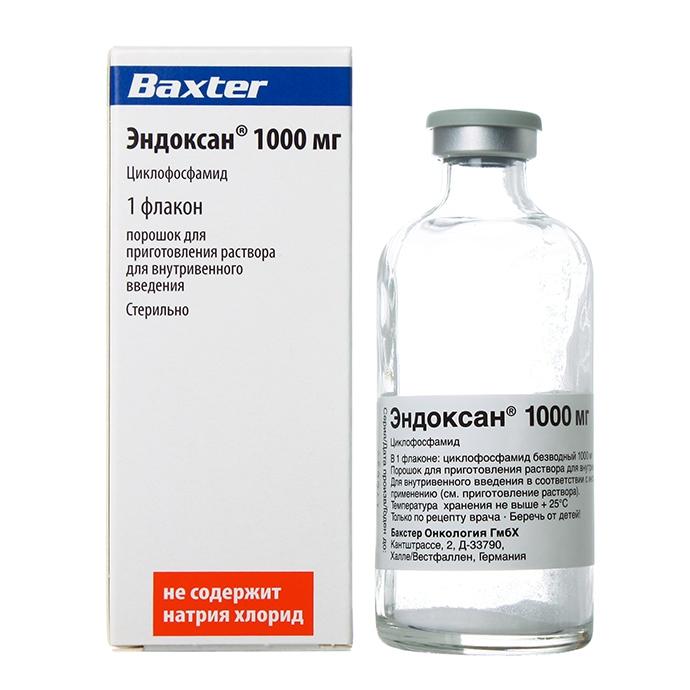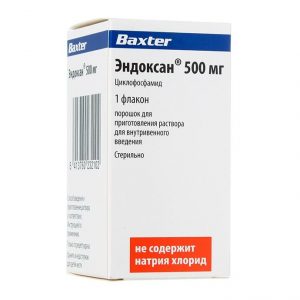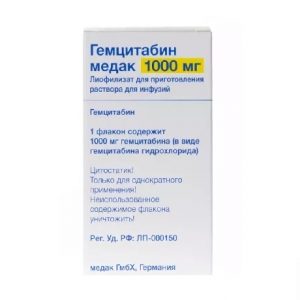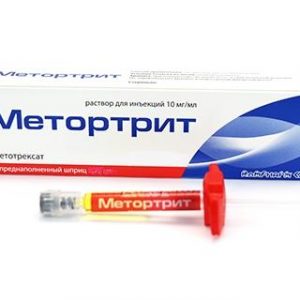Description
Latin name
ENDOXAN
Release form
Powder for the preparation of a solution for iv administration.
Packing
In a bottle of 75 ml. In a cardboard box 1 bottle.
Pharmacological action of
Phramacodynamics
Cyclophosphamide is an alkylating cytostatic drug chemically similar to nitrogen mustard analogues.
The mechanism of action is believed to include cross-linking between DNA and RNA strands, as well as inhibition of protein synthesis.
Pharmacokinetics
The content of the drug in the blood after intravenous and oral administration is the same. It is metabolized mainly in the liver under the influence of the microsomal oxidase system, forming active alkylating metabolites (4-OH cyclophosphamide and aldophosphamide), some of which undergo further transformation to inactive metabolites, some are transported to cells, where, under the influence of phosphatases, they turn into metabolites with a cytotoxic effect. Cmax of metabolites is reached in plasma 2-3 hours after iv administration.
The binding of an unchanged drug to blood plasma proteins is negligible (12-14%), but some metabolites bind more than 60%. It penetrates the BBB to a limited extent.
Cyclophosphamide is excreted by the kidneys mainly in the form of metabolites, however, 5-25% of the administered dose is excreted in the urine unchanged, as well as with bile. T1 / 2 is 7 hours for adults and 4 hours for children.
Indications
Acute lymphoblastic and chronic lymphocytic leukemia
lymphogranulomatosis
non-Hodgkin lymphoma
multiple myeloma
breast cancer
ovarian cancer
neuroblastoma srdplkrd myrdroblastoma myrdroblastoma myrdroblastoma
Endoxan is also used in combination with other antitumor drugs to treat lung cancer, germ cell tumors, cervical cancer, bladder cancer, soft tissue sarcoma, reticulosarcoma, Ewing sarcoma, Wilms tumor, prostate cancer.
As an immunosuppressive agent, Endoxan is used for progressive autoimmune diseases (rheumatoid arthritis, psoriatic arthritis, collagenoses, autoimmune hemolytic anemia, nephrotic syndrome) and to suppress the transplant rejection reaction.
Contraindications
Severe bone marrow dysfunction
cystitis
urinary retention
active infections
pregnancy
lactation
hypersensitivity to cyclophosphamide or other excipients that are part of the drug.
Caution: in case of severe diseases of the heart, liver and kidneys, adrenalectomy, gout (history), nephrourolithiasis, inhibition of bone marrow function, bone marrow infiltration by tumor cells, prior to radiation or chemotherapy.
Composition
1 bottle contains:
Active substances: cyclophosphamide monohydrate 1069 mg, which corresponds to a cyclophosphamide content of 1000 mg.
Dosage and administration of
Endoxan is part of many chemotherapeutic treatment regimens, and therefore, when choosing a dosing regimen in each individual case, one should be guided by the data of the specialized literature.
Most commonly used doses and regimens for adults and children with parenteral administration: 50-100 mg / m2 daily for 2 3 weeks
100-200 2 mg / m2 or 3 times a week for 3 4 weeks, by mouth or iv
600-750 mg / m2 once every 2 weeks iv
1500-2000 mg / m2 once every 3-4 weeks to a total dose of 6-14 g
When using the drug in combination with other anticancer drugs, it may be necessary to reduce the dose of both Endoxan and other drugs.
Before iv administration, the drug is dissolved in water for injection or 0.9% sodium chloride solution to a concentration of 20 mg / ml.
Drug Interaction
Inducers of microsomal oxidation in the liver may induce microsomal metabolism of cyclophosphamide, which leads to the increased formation of allylating metabolites, thereby reducing the half-life of cyclophosphamide and increasing its activity.
The use of cyclophosphamide, which causes a marked and prolonged suppression of cholinesterase activity, enhances the action of suxamethonium, and also reduces or slows the metabolism of cocaine, thereby increasing and / or increasing the duration of its effect and increasing the risk of toxic action.
When used with allopurinol, toxicity to the bone marrow can also be enhanced.
With the simultaneous use of cyclophosphamide, allopurinol, colchicine, probenecid, sulfinpyrazone, dosage adjustment of anti-gout drugs may be required. The use of uricosuric anti-gout drugs may increase the risk of nephropathy, associated with increased uric acid formation when using cyclophosphamide.
Cyclophosphamide may increase anticoagulant activity as a result of decreased synthesis of coagulation factors in the liver and impaired platelet formation, but may also decrease anticoagulant activity through an unknown mechanism.
Because grapefruit contains a compound that may impair the activation of cyclophosphamide and thus its effect, patients are not advised to eat grapefruit or drink grapefruit juice.
Cyclophosphamide enhances the cardiotoxic effect of doxorubicin and daunorubicin.
Other immunosuppressants (azathioprine, chlorambucil, ACS, cyclosporine, mercaptopurine) increase the risk of infection and secondary tumors.
Increased risk of acute skeletal muscle necrosis and acute renal failure may occur with concomitant use of lovastatin in patients with heart transplantation.
Drugs that cause myelosuppression, as well as radiation therapy – may be an additive suppression of bone marrow function.
The concomitant use of cytarabine in high doses with cyclophosphamide in preparation for bone marrow transplantation led to an increase in the incidence of cardiomyopathy followed by fatal outcome.
Overdose
The specific antidote for overdose is unknown. In cases of overdose, supportive measures should be used, including appropriate treatment for infections, myelosuppression, or cardiotoxicity.
Storage conditions
Store at a temperature not exceeding 25 ° C, out of the reach of children.
Expiration
3 years.
Deystvuyuschee substances
tsiklofosfamida
Dosage form
Dosage form
infusion solution




